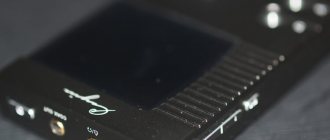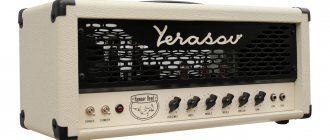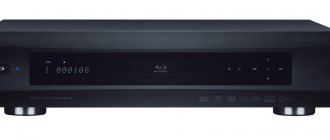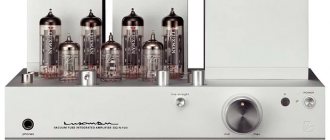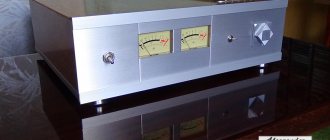The Chinese company Zhuhai Spark Electronic Equipment is known to the world for its Cayin brand, under which it makes components for audiophiles and music lovers. In 2013, the company began producing portable players, which became very popular among fans of high-quality personal audio. However, the basis of the Cayin catalog has always been and remains stationary components, about which, oddly enough, a little less is known. The company's products include tube and transistor amplifiers, digital players, CD players, acoustics and a number of accessories. And today we will look at the “I” series line, first presented to the public four years ago.
Today, the I Series includes the iDAP-6 digital desktop player, the iDAC-6 digital-to-analog converter, and the iHA-6II headphone amplifier (marketed simply as the iHA-6). By the way, a new modification of the iDAC-6MK2 DAC will be launched in the summer, but more on that later.
First of all, it is worth noting that all three devices that make up the series are proposed to be used as a single system. On the other hand, any of the devices can be freely used separately. For example, the iDAP-6 digital transport can be easily connected to a third-party DAC and output the signal to an existing power amplifier. Thus, you will get a home audio system with almost unlimited possibilities in terms of playing digital Hi-Res music.
If we consider this trinity in the format of one system, then everything is very harmonious: the devices fit each other perfectly both in size and appearance, and in functionality.
Cayin iDAC-6 DAC and Cayin iHA-6II Headphone Amplifier
Let's start with the pair iDAC-6 and iHA-6II, which appeared on the market a little earlier than the iDAP-6 transport and from the very beginning was positioned as one system. Both devices have aluminum cases with round metal buttons and large, absolutely identical control knobs on the right side of the front panel.
Housings are made of sandblasted aluminum
The iDAC-6 digital-to-analog converter is a multifunctional, fully balanced device. First of all, of course, this model is designed for the aforementioned headphone amplifier, but the manufacturer does not prohibit (and even suggests) using the iDAC-6 as an all-format DAC for a home stereo system. It is important to note that the device can also work as a preamplifier with volume control (switchable mode).
Another important feature is tube and transistor modes. The tube output is built on four 6N16B tubes. Depending on the desired sound, you can choose between tube or transistor mode. It should be noted that both schemes are only possible with RCA outputs, and when using balanced connectors, the device operates only in tube mode. Most owners of this DAC are dissatisfied with this feature, but, on the other hand, on Head-fi.org, for example, many write that it is with active lamps that the DAC fully opens up, making the sound warm and melodic.
The iDAC-6 is capable of decoding audio in PCM format up to 32-bit/384 kHz (via USB) and DSD 128. The source can be a computer, CD player or special Cayin iDAP-6 transport. The signal is captured via USB, coaxial or optical inputs. There is also AES/EBU connection. When switching through this connector or through a coaxial one, it is possible to decode the DoP format coming from the corresponding source.
Dual 6N16B triodes in an iDAC-6 circuit (left). Japanese ALPS RK27114 potentiometer in the iHA-6II amplifier (right)
The DAC is based on two chips (one per channel) AKM AK4490. According to Cayin, this is enough for almost any modern musical task. The conversion block is followed by a four-channel LPF filter, Texas Instruments OPA604/OPA2604 operational amplifiers and the already mentioned tubes. You can output the finished analog signal via RCA or balanced XLR outputs.
According to the test on the Headfonics.com website, the decoded analog signal of the iDAC-6 is slightly colored - there is an additional “openness and dynamism” in the sound. The author of the test also writes that the DAC makes the bass denser and the vocals more energetic, but these abilities slightly affect the detail of the sound.
An LED display was placed on the front panel of the iDAC-6 at an angle of 15°. This solution is designed not only to improve the appearance of the device, but also to make the information on the screen more readable. Below the display there are three buttons: source selection, timbre (tube/transistor) and preamplifier on/off. The massive control wheel on the right performs two functions: volume control (when Pre mode is on) or menu navigation, activated by pressing the wheel. On the left is the Power button to turn on the device. By the way, after turning on the DAC it takes 15 seconds to warm up and go into active mode.
The iHA-6II headphone amplifier is also built on a fully balanced circuit. According to Cayin, this device will cope with any of the most complex headphones, and the sound quality will please the most demanding personal audio lover. The device produces a maximum of 2,200 mW into 32 ohms with an unbalanced connection and 7,000 mW into 32 ohms with a balanced connection.
The rear panel of the iHA-6II has a pair of balanced XLR and a pair of RCA inputs - you can connect two sources simultaneously
The manufacturer draws attention to the fact that the iHA-6II is based on discrete components. The push-pull circuit of the device uses MOSFET HUF7633 transistors, Toshiba K246 FET transistors and WIMA capacitors. To adjust the volume, a Japanese ALPS potentiometer is used.
Depending on the mode (high-current/low-current), the amplifier power changes: 1,100 mW + 1,100 mW (32 Ohms) or 2,200 mW + 2,200 mW (32 Ohms). With a balanced connection, you can get 5,000 mW + 5,000 mW and 7,000 mW + 7,000 mW, respectively. Coupled with gain control (two levels offered) and low-impedance/high-impedance headphone jacks, the user gets a very versatile amplifier that adapts to any headphones, including planar ones.
240 mm x 252 mm x 69 mm (W x D x H)
In a test from the already mentioned Headfonics.com they write that the sound of the iHA-6II amplifier is characterized by purity and neutrality. The device does not color the sound in any way. The author even “lacks musicality,” but he achieves what he wants through the use of a “musical” iDAC-6 and headphones.
The rear panel of the iHA-6II has a pair of balanced XLR and a pair of RCA inputs - you can connect two sources at the same time. Of greater interest is the front panel, where not everything is so simple. Let's start with the connectors. On the left there is a low-impedance TRS output for an unbalanced connection and a 3-pin left output for a balanced connection is also implemented there. In the center there is a high-impedance TRS output and a right balanced channel. The last connector on the right is for a balanced XLR connection with a 4-pin connector (stereo).
As for the controls, the Power button is used to turn the device on/off, the Source button changes the source, Current sets one of two current modes, and Gain, accordingly, switches the gain. The wheel here is responsible only for the volume level.
Specifications
| DAC: | Burr-Brown PCM1795 |
| Digital signal: | up to 96 kHz/24 bit |
| Frequency range: | 20–70,000 Hz |
| Output power: | 600 mW (32 Ohm) |
| Harmonic Distortion: | 0.02 % |
| Signal to noise ratio: | 101 dB |
| Battery: | 3700 mAh/3.7 V |
| Operating time on one charge: | 19 hours, (in amplifier mode, with a 32Ω load) 9 hours, (in DAC/USB input mode, with a 32Ω load) |
| Charging time: | about 5 hours (using DC5V/2A adapter) |
| Dimensions: | 136x63x15 mm |
| Weight: | 185 g |
Network player Cayin iDAP-6
Now let's move on to iDAP-6. The manufacturer itself calls this device “a digital transport and network player with support for all popular formats.” As a transport, iDAP-6 can be connected to an external USB drive, SSD, HDD and SD card (there is a slot on the front), and as a network player, iDAP-6 can be connected via Ethernet or Wi-Fi to local storage (NAS) and any home device operating according to DLNA and Samba standards.
A good set of capabilities, but it is not limited to this: Cayin places a special emphasis on the player’s ability to work with mobile gadgets via AirPlay and Bluetooth 4.1. The device not only receives audio via Bluetooth, but also outputs a signal via this protocol using aptX and SBC codecs. In other words, you can directly connect Bluetooth headphones or a speaker to the iDAP-6.
You can output the digital stream from the transport via USB (USB output mode is activated when the appropriate DAC is connected), optical connector, coaxial RCA, coaxial BNC and AES/EBU (XLR). There is also HDMI, which only carries the I²S signal. The manufacturer points out that I²S is not an industry standard, so work with third-party devices is not guaranteed, but there will be no problems with the native iDAC-6MK2 (read about it below).
The list of file formats compatible with the iDAP-6 player is impressive: DSF, DIFF, SACD-ISO, AIFF, WAV, FLAC, ALAC, APE, WMA, MP3, OGG, AAC. The device supports PCM up to 32-bit/384 kHz, DSD256 via I²S, as well as DoP128 when output via USB and DoP64 when working with other digital connectors.
The iDAP-6 design is based on ultra-precise femtosecond oscillators with jitter below 0.1 picoseconds and minimal phase noise. According to Cayin, ultra-low jitter has become one of the factors for high-quality music playback - the sound is natural and “non-digital”. The company also focuses on a low-noise isolated power supply with a toroidal transformer of its own production. Finally, the iDAP-6 contains Japanese Nichicon capacitors, which have a positive effect on the detail and transparency of the sound.
To control the entire system and play music, the iDAP-6 was equipped with a large (3.95-inch) color AMOLED display. The company has tried to make the menu interface "intuitive, visually pleasing and comprehensive." According to Cayin, all information is presented to the user in the most optimal way. Menu navigation is carried out by a large wheel on the right side of the player, and the same knob functions as the Enter button. To the left of the display there is a button to go back and a large illuminated button to turn on the device.
An SD card slot and a USB port were hidden under the cover in the lower left corner
It should be noted that transport can also be controlled via a mobile device. In this case, communication with the device occurs using HiByLink technology based on Bluetooth. You must install the special HiByMusic application on your mobile device that acts as a remote control. After pairing, the user will be able to control iDAP-6 from his gadget. Via HiByLink you can also play music, but only that stored on connected USB storage devices or an SD card. The good thing about the application is that it displays some information about the content that is not available on the screen of the player itself. In addition, the program has file search and management, including creating playlists.
Cayin Desktop Trio
As already mentioned, the iDAP-6 player can work with any DAC, but the manufacturer strongly recommends using the device as part of a system of three components: iDAC-6, iHA-6II and iDAP-6. Cayin even has a name for this kit - “Desktop Trio” (translated from English - “Desktop Trio”).
In design and size, all devices fit perfectly. The width of any of the components is 240 mm, height - 69 mm. Series I housings are made of aluminum. In terms of weight, the amplifier and DAC weigh 3.8 kg each, while the transport weighs 3.3 kg. Cayin emphasizes that when creating the series, the designers focused on compactness, minimalism and style. The manufacturer believes that the system will fit well into a modern interior.
Set
| C5DAC |
| USB/Micro USB cable for charging/connecting to PC |
| Micro USB/Micro USB cable for connecting to an Android device |
| 3.5mm/3.5mm cable |
| set of silicone “feet” |
| 3.5mm/coaxial cable |
| a pair of rubber bands for attaching to another device |
New modification of the Cayin iDAC-6MK2 DAC
A new modification of the iDAC-6MK2 DAC, already mentioned at the beginning of the article, will appear on the market in June. The model will be capable of decoding DSD512 and PCM up to 32bit/768kHz via USB or I²S. Like the first version, MK2 will allow you to select tube or transistor modes. There will also be an independent preamplifier section on board the device. The heart of the system is the ESS Saber ES9028PRO chip.
iDAC-6MK2 received an AMOLED display with a resolution of 640 x 360
The iDAC-6MK2's controls have been repositioned slightly, but overall there haven't been any major changes. However, the display has undergone a serious transformation: now it is color and large (like a vehicle, but with a higher resolution). The manufacturer writes that the same AMOLED module is found in the top-end CS-100DAC.
According to Cayin itself, the release of an updated DAC in the I series is needed to keep the line up to date for the industry. Like the previous DAC, the new device will be fully compatible with the iHA-6II headphone amplifier and iDAP-6 transport player.
Official website: Cayin iDAC-6, Cayin iHA-6II, Cayin iDAP-6
Price: Cayin iDAC-6 - 42,990 rubles, Cayin iHA-6II - 42,990 rubles, Cayin iDAP-6 - 42,990 rubles
Sound
The following headphones were used for listening: Etymotic ER-4S, Etymotic ER-4SR, Beyerdynamic DT 1350, Beyerdynamic DT 250/250, Phonon SMB-02, Hifiman HE-4.
With all the headphones, the device played properly. I didn’t notice any genre preferences on the device.
I would describe the sound of the Cayin C5DAC as neutral. The device unexpectedly pleases with its powerful and voluminous feed with good separation of tools. He is also very musical: he plays all the material at the level of a maestro, with soul and detachment from vanity. No obvious errors or distortions were found. To be honest, I didn’t expect such immersion from such a “lightweight” box.
By the way, I advise device owners to discharge 3-4 full columns of battery. It feels like the sound becomes smoother, cleaner and more cohesive after 30-50 hours. Whatever musical material I played, everything was played with a bang. But the device will not “powder” a bad recording: it will immediately cut to the heart of the matter – with all its imperfections and mistakes.
As for the volume, on the headphones that I connected, everything “swayed” even at “lower gain”. Unfortunately, I gave the Hifiman HE-6 away, but with the HE-4 I checked out the new product. Paired with the C5DAC, they sounded quite decent, especially considering the “tightness” of these lugs. In general, the reviewer is shocked! The sound of a portable DAC (we cannot compare it with stationary equipment) turned out to be quite up to par.
The device draws a panoramic picture well - both in depth and in width. The musical canvas is played quite dense, holographic, with good detail. For all its smoothness, the Cayin C5DAC perfectly conveys the emotions of a musical composition. It's really nice to listen to with the DAC. His “inner voice” does not tire you and even encourages you to listen to music that continues in the evening and at night...
HF – without peaks, “loudness”, and dips. If it were not for some friability of this register, then everything would be just great. In terms of quantity, there are exactly as many of them as there should be - for my taste, at least.
Midrange – the midrange is smooth, detailed, without excessive roughness, peaks and dips. The melody is presented with proper expression and is very musical. In general, I would like to find fault, but there is nothing to do.
LF – with good impact and weight, they beautifully draw depth and thereby give the overall picture fullness. In general, surprisingly, everything is also very good. At the beginning, it seemed to me that the low frequencies lacked a little control, but over time, no matter how hard I tried, I could not find anything concrete. Perhaps this is the result of bringing the battery power back to normal or the influence of some kind of magical heating. In a word, my questions about the woofer somehow disappeared.



